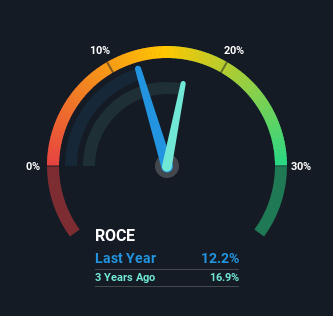If we want to find a stock that could multiply over the long term, what are the underlying trends we should look for? Firstly, we'd want to identify a growing return on capital employed (ROCE) and then alongside that, an ever-increasing base of capital employed. This shows us that it's a compounding machine, able to continually reinvest its earnings back into the business and generate higher returns. Although, when we looked at Stadler Rail (VTX:SRAIL), it didn't seem to tick all of these boxes.
Understanding Return On Capital Employed (ROCE)
For those who don't know, ROCE is a measure of a company's yearly pre-tax profit (its return), relative to the capital employed in the business. Analysts use this formula to calculate it for Stadler Rail:
Return on Capital Employed = Earnings Before Interest and Tax (EBIT) ÷ (Total Assets - Current Liabilities)
0.12 = CHF190m ÷ (CHF4.9b - CHF3.4b) (Based on the trailing twelve months to June 2021).
Therefore, Stadler Rail has an ROCE of 12%. On its own, that's a standard return, however it's much better than the 9.9% generated by the Machinery industry.
View our latest analysis for Stadler Rail

In the above chart we have measured Stadler Rail's prior ROCE against its prior performance, but the future is arguably more important. If you'd like to see what analysts are forecasting going forward, you should check out our free report for Stadler Rail.
What Does the ROCE Trend For Stadler Rail Tell Us?
In terms of Stadler Rail's historical ROCE movements, the trend isn't fantastic. Around three years ago the returns on capital were 17%, but since then they've fallen to 12%. Although, given both revenue and the amount of assets employed in the business have increased, it could suggest the company is investing in growth, and the extra capital has led to a short-term reduction in ROCE. If these investments prove successful, this can bode very well for long term stock performance.
Another thing to note, Stadler Rail has a high ratio of current liabilities to total assets of 68%. This effectively means that suppliers (or short-term creditors) are funding a large portion of the business, so just be aware that this can introduce some elements of risk. Ideally we'd like to see this reduce as that would mean fewer obligations bearing risks.
Our Take On Stadler Rail's ROCE
In summary, despite lower returns in the short term, we're encouraged to see that Stadler Rail is reinvesting for growth and has higher sales as a result. These growth trends haven't led to growth returns though, since the stock has fallen 24% over the last year. So we think it'd be worthwhile to look further into this stock given the trends look encouraging.
If you'd like to know more about Stadler Rail, we've spotted 4 warning signs, and 2 of them make us uncomfortable.
For those who like to invest in solid companies, check out this free list of companies with solid balance sheets and high returns on equity.
New: Manage All Your Stock Portfolios in One Place
We've created the ultimate portfolio companion for stock investors, and it's free.
• Connect an unlimited number of Portfolios and see your total in one currency
• Be alerted to new Warning Signs or Risks via email or mobile
• Track the Fair Value of your stocks
Have feedback on this article? Concerned about the content? Get in touch with us directly. Alternatively, email editorial-team (at) simplywallst.com.
This article by Simply Wall St is general in nature. We provide commentary based on historical data and analyst forecasts only using an unbiased methodology and our articles are not intended to be financial advice. It does not constitute a recommendation to buy or sell any stock, and does not take account of your objectives, or your financial situation. We aim to bring you long-term focused analysis driven by fundamental data. Note that our analysis may not factor in the latest price-sensitive company announcements or qualitative material. Simply Wall St has no position in any stocks mentioned.
About SWX:SRAIL
Stadler Rail
Through its subsidiaries, engages in the manufacture and sale of trains in Switzerland, Germany, Austria, Western and Eastern Europe, the Americas, the CIS countries, and internationally.
High growth potential with adequate balance sheet.
Similar Companies
Market Insights
Community Narratives




